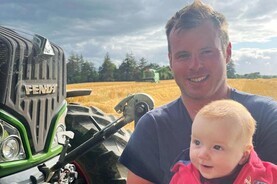Plant protein has come increasingly under the microscope in recent years with increased questioning of the origin of our protein sources and the growing interest in non-GM food trails. The Irish coupled protein aid scheme has served to generate considerably increased interest in field beans and all protein crops so it is hardly surprising that we are seeing increasing interest in soya beans as a crop in this part of the world. The importance of soya bean meal as a protein source for animal feed is unquestionable. But soya beans themselves are, in the main, not a safe source of protein for animals because of the presence of anti-nutritional factors such as trypsin inhibitors, phytic acid and tannins. These are also present in faba beans, but at lower levels.
Plant protein has come increasingly under the microscope in recent years with increased questioning of the origin of our protein sources and the growing interest in non-GM food trails. The Irish coupled protein aid scheme has served to generate considerably increased interest in field beans and all protein crops so it is hardly surprising that we are seeing increasing interest in soya beans as a crop in this part of the world.
The importance of soya bean meal as a protein source for animal feed is unquestionable. But soya beans themselves are, in the main, not a safe source of protein for animals because of the presence of anti-nutritional factors such as trypsin inhibitors, phytic acid and tannins. These are also present in faba beans, but at lower levels.
In general, the anti-nutritional factors in soya beans are denatured by heat. The physical extraction of oil from the seeds to leave the meal provides enough heat to denature these toxins and that is why we feed soya meal rather than soya beans. These same anti-nutritional factors are found in faba beans (field beans). It is believed that the bulk of the anti-nutritional factors occur in the cortex or hull of the beans.

The final flowers reflect the determinate growth in this soya bean variety.
For crops that ripen late in the season (or not at all), the option to ensile can help make them attractive to growers but there is a lot of information needed on the fate of the anti-nutritional factors in a silage, the state and quality of the protein, the optimum harvest window for ensiling and subsequent animal performance.
The need for locally produced protein for animal feed is a growing trend in parts of the EU so it is hardly surprising that countries are looking to see if they can grow the crop and how dependable it will be.
This year, we are growing a small area of soya beans in Ireland, there is already an area in Britain and the Dutch are now up to 500ha.
Soya in Kildare
Earlier this week, I met with John Fallon and David Shortall in Castledermot. John is farm manager on this Quinns of Baltinglass farm and he is growing about 15ac of soya beans this year. David is agri sales manager for Quinns and he worked with the crop in Canada in recent years.
David told me that he had taken advice on variety selection from Soya-UK and that he is growing a 0000 maturity class variety, which is earliest maturing and gives the crop the best chance of ripening in our climate. The variety is called Siverka.
John emphasised that planting is slightly trickier than many other crops in that the seed has to be sown deep enough to protect it from residual sprays and the pigeons who just love these seeds, but not too deep as to hinder emergence. The target is about 2.5cm deep and there is not too much leeway either side.
Seed size was described as being similar to but slightly smaller than a pea, but larger than a maize seed. The target is to establish 55 plants per m2.
John planted this crop with a standard Horsch drill with coulters at about five-inch spacings. The crop received basic P and K at sowing followed by herbicides post-planting and post-emergence. The crop is continuing to produce new pods but it looks like flowering is finished at this point.
David said that the intention is to harvest the beans rather than ensile and the estimated harvest date is the last week in September to the first week in October. John is already considering the potential for difficulties at harvest, given that the crop has produced pods very low down on the stem and that these pods hang down rather than stand up.
“The table will really need to hug the ground to minimise losses,” John said.
If the season begins to run very late there is an option to ensile but it could be an equally big challenge to lift all of the pods from the soil surface.
Read more
Dutch soya bean crop expanding





SHARING OPTIONS: